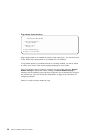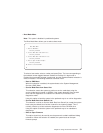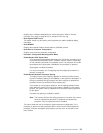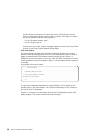
MEMORY CONFIGURATION/DECONFIGURATION MENU
77. Enable/Disable Memory Repeat Gard: Currently Enabled
78. Runtime Recoverable Error Repeat Gard: Currently Enabled
1. Memory card
98. Return to Previous Menu
After you select the memory card option by entering 1, a menu displays, allowing the
selection of a memory book. The following is an example of this menu.
MEMORY CONFIGURATION/DECONFIGURATION MENU
1: 16.16(00, -) Configured by system 2: 17.17(00, -) Configured by system
3: 18.18(00, -) Configured by system 4: 19.19(00, 1) Partially deconfigured by system
98. Return to Previous Menu
Note: This table is built from vital product data collected during the last boot
sequence. The first time the system is powered on, or after the system’s
nonvolatile RAM (NVRAM) has been erased, this table may be empty. The
table is rebuilt during the next boot into AIX.
The fields in the previous table represent the following:
Column 1
1. Menu selection index/book number
Column 2
xx.xx : Book address used by service processor
Column 3
(00, -) Error/deconfiguration status
The error status of the each memory book is indicated by (AB, -1) where B indicates
the number of errors and A indicates the type of error according to the following:
1. Bring-up failure
2. Run-time non-recoverable failure
3. Run-time recoverable failure
4. Group integrity failure
5. Non-repeat-gardable error. The resource may be reconfigured on the next boot.
An error status of (00, -) (for example, 11.16(00, -)) indicates that the memory book
has not had any errors logged against it by the service processor, and it is fully
configured.
The field after the error status will be a “-”, “0”, or “1”. The dash indicates that the
memory book is fully configured. A zero or a one indicates that memory repeat gard
36 Eserver pSeries 690 User’s Guide


















